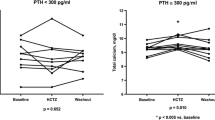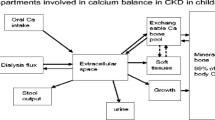Abstract
Background/Aims
Aluminum (Al) is an ingredient of a variety of foodstuffs and medications as well as of domestic water supplies. The patients with chronic kidney disease (CKD) are more susceptible to bone toxicity of Al. The aim of the study was to investigate the interactions between serum Al, parathyroid hormone (PTH) and active vitamin-D in CKD.
Methods
A total of 10 pediatric patients with CKD and 20 healthy controls were enrolled in study. The blood calcium, aluminum, PTH, alkaline phosphatase and phosphorus were evaluated at onset and following a regimen of oral 1,25 dihydroxycholecalciferol (1,25 DHC) for 4 weeks.
Results
Although median values of PTH, calcium, phosphorus and alkaline phosphatase did not differ (P > 0.05) after calcitriol administration, the aluminum levels (median: 27.2 ng/ml, range: 11.3–175) declined significantly (median: 3.8 ng/ml, range: 0.64–11.9) after a regimen of oral 1,25 DHC for 4 weeks in all participants (P < 0.05). The median levels of aluminum after 1,25 DHC did not show statistically significant difference with median aluminum levels of healthy controls (median: 2.5 ng/ml, range: 0.2–33.2) (P < 0.05).
Conclusion
Calcitriol may lead to decline in serum Al levels in CKD patients.

Similar content being viewed by others
References
Alfrey AC, Hegg A, Craswell P (1980) Metabolism and toxicity of aluminum in renal failure. Am J Clin Nutr 33:1509–1516
Yokel RA, McNamara PJ (2001) Aluminium toxicokinetics: an updated minireview. Pharmacol Toxicol 88:159–167
Priest ND (2004) The biological behaviour and bioavailability of aluminium in man, with special reference to studies employing aluminium-26 as a tracer: review and study update. J Environ Monit 6:375–403
Alfrey AC (1986) Aluminum metabolism. Kidney Int 29:S8–S11
Felsenfeld AJ, Gutman RA, Llach F et al (1982) Osteomalacia in chronic renal failure: a syndrome previously reported only with maintenance dialysis. Am J Nephrol 2:147–154
Baydar T, Sahin G, Aydin A et al (1996) Al/Cr ratio in plasma and urine of diabetics. Trace Elem Electrolytes 13:50–53
Adler AJ, Berlyne GM (1985) Duodenal aluminum absorption in the rat: effect of vitamin D. Am J Physiol 249:G209–G213
Cannata-Andia JB, Fernandez-Martin JL (2002) The clinical impact of aluminum overload in renal failure. Nephrol Dial Transplant 17:9–12
Ittel TH (1993) Determinants of gastrointestinal absorption and distribution of aluminium in health and uraemia. Nephrol Dial Transplant 8:17–24
Hernandez JD, Wesseling K, Salusky IB (2005) Role of parathyroid hormone and therapy with active vitamin D sterols in renal osteodystrophy. Semin Dial 18:290–295
Malluche HH (2002) Aluminium and bone disease in chronic renal failure. Nephrol Dial Transplant 17(Suppl 2):21–24
Pei Y, Hercz G, Greenwood C et al (1992) Non-invasive prediction of aluminum bone disease in hemo and peritoneal dialysis patients. Kidney Int 41:1374–1382
Avila-Díaz M, Matos M, García-López E et al (2006) Serum markers of low-turnover bone disease in Mexican children with chronic kidney disease undergoing dialysis. Perit Dial Int 26:78–84
Malluche HH, Faugere MC (1985) Aluminum: toxin or innocent bystander in renal osteodystrophy. Am J Kidney Dis 6:336–341
Andress DL, Ott SM, Maloney NA et al (1985) Effect of parathyroidectomy on bone aluminum accumulation in chronic renal failure. N Engl J Med 312:468–473
Hirschberg R, von Herrath D, Voss R et al (1985) Organ distribution of aluminium in uremic rats: influence of parathyroid hormone and 1, 25-dihydroxyvitamin D3. Miner Electrolyte Metab 11:106–110
Quarles LD, Dennis VW, Gitelman HJ et al (1985) Aluminum deposition at the osteoid-bone interface. An epiphenomenon of the osteomalacic state in vitamin D-deficient dogs. J Clin Invest 75:1441–1447
Chan JC, Jacob M, Brown S et al (1988) Aluminum metabolism in rats: effects of vitamin D, dihydrotachysterol, 1, 25-dihydroxyvitamin D and phosphate binders. Nephron 48:61–64
Sanchez CP (2006) Adynamic bone revisited: is there progress? Perit Dial Int 26:43–48
Author information
Authors and Affiliations
Corresponding author
Rights and permissions
About this article
Cite this article
Azik, F.M., Ekim, M., Sakallioglu, O. et al. A different interaction between parathyroid hormone, calcitriol and serum aluminum in chronic kidney disease; a pilot study. Int Urol Nephrol 43, 467–470 (2011). https://doi.org/10.1007/s11255-010-9784-x
Received:
Accepted:
Published:
Issue Date:
DOI: https://doi.org/10.1007/s11255-010-9784-x




